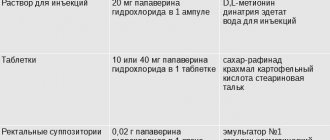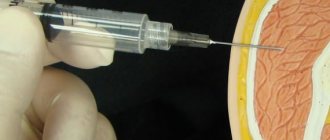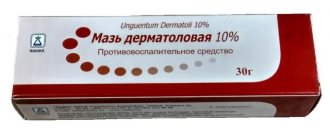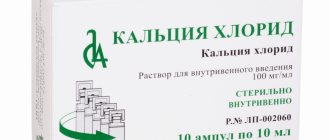Heartburn. Is this a familiar phenomenon? It bakes, it hurts in the throat, esophagus, behind the sternum. This condition is debilitating, provokes inflammation in the nasopharynx and oral cavity, and has similar symptoms to heart diseases. Scientifically, this phenomenon is called gastroesophageal reflux. This is a pathological condition in the gastrointestinal tract.
Heartburn is not an independent disease, but a symptom. You need to find out the cause of the problem and get rid of it. But our people love to get treatment using advertising and online forums. In advertisements for antacids, heartburn medications, courageous firefighters extinguish fires in the mouth and esophagus. And everything is fine... For a while... One of the advertised drugs for heartburn is Gaviscon suspension; before treatment you need to read the instructions for use.
Composition and release form
The medicine Gaviscon has 2 release forms: tablets and suspension for oral use.
Tablets with a chewable base, slightly flat with a round shape and a light shade. They have minor inclusions over the entire surface, with a pleasant smell of mint or lemon. Packaged in cardboard packaging with 2-4 blisters, each containing 8 pieces. Or in a polypropylene container of 16 tablets with attached instructions for use.
Gaviscon suspension for oral administration has a uniform consistency, light color and menthol flavor. Sold in a dark glass bottle with a volume of 100, 150 or 300 ml.
The active components of the drug are sodium bicarbonate and alginate, calcium carbonate. Their concentration varies depending on the dosage form. Excipients: mint flavor, magnesium stearate, macrogol, aspartame, mannitol, acesulfame potassium.
Drug price
Heartburn is a frequent “guest” after celebrations from a feast
The cost of the antacid depends on the bottle capacity:
- In Ukraine, a 150 ml suspension will cost the buyer 120 UAH. And the drug in sachets marked for pregnant women – 400 UAH.
- In Russia, a bottle will cost from 207 to 216 rubles. Sachets for pregnant women will cost an average of 400 rubles.
- The cost of the drug in Belarus is currently unknown. Perhaps the drug is being re-registered or is not being imported.
pharmachologic effect
Gaviscon is a drug for symptomatic treatment. Thanks to the antacid group, it has the property of neutralizing hydrochloric acid in the stomach cavity.
After oral administration, the active ingredients immediately react with the acidic environment. As a result, a gel base with a neutral pH is formed. Due to it, a protective film is formed on the mucous surface of the stomach, preventing gastroesophageal reflux from developing within 4 hours.
In case of severe pathological process, the gel penetrates into the digestive tract, ahead of the entry of gastric contents, where it helps to reduce the irritant factor on the esophageal mucosa.
The therapeutic effect of the drug occurs 3-4 minutes after administration.
The drug does not have general bioavailability. Its pharmacological activity does not extend beyond the gastrointestinal tract. Therefore, the active ingredients rarely penetrate into the bloodstream. This occurs when the therapeutic dose of the drug is increased. Then it is excreted from the body through the kidneys with urine unchanged.
Gaviscon
Gaviscon ®
(lat.
Gaviscon
) - antacid* alginate drug.
Anti-regurgitant. Sometimes called gaviscon
.
Gaviscon ® forte
(lat.
Gaviscon forte
) is a drug that differs from Gaviscon in the increased content of the active substance - sodium alginate.
Gaviscon ® Double Action
is a new version of the drug Gaviscon registered in Russia in April 2012. Upon entering the stomach, Gaviscon quickly reacts with its acidic contents, resulting in the formation of an alginate gel that has an almost neutral acidity value (gel pH about 7). The gel forms a protective barrier on the surface of the stomach contents, preventing the occurrence of gastroesophageal reflux. In case of regurgitation or reflux, the gel enters the esophagus, where it has a neutralizing effect on hydrochloric acid and pepsin that enter during reflux and additionally protects the mucous membrane of the esophagus.
Composition of Gaviscon
Gaviscon in Russia is sold in several dosage forms: Gaviscon in the form of a suspension, Gaviscon forte in the form of a suspension (anise or mint), Gaviscon - lemon chewable tablets and Gaviscon - mint chewable tablets.
Gaviscon Double Action - in the form of chewable tablets and suspension for oral administration. Active substances
drug
Gaviscon (suspension)
. 10 ml of oral suspension contains: sodium alginate 500 mg, sodium bicarbonate 267 mg and calcium carbonate 160 mg.
Active substances
drug
Gaviscon forte.
10 ml of oral suspension contains: sodium alginate 1000 mg, potassium bicarbonate 200 mg. (Gaviscon forte, like Gaviscon, contains calcium carbonate, however, unlike Gaviscon, in Gaviscon forte it is classified as an excipient.)
Active ingredients
of chewable tablets
. One Gaviscon tablet contains sodium alginate 250 mg, sodium bicarbonate 133.5 mg and calcium carbonate 80 mg.
Excipients
suspensions of Gaviscon and Gaviscon forte: carbomer, sodium saccharinate, methyl parahydroxybenzoate, propyl parahydroxybenzoate, peppermint oil, sodium hydroxide, purified water. Excipients of Gaviscon tablets: mannitol, macrogol, magnesium stearate, aspartame, copovidone, acesulfame potassium, lemon (or mint) flavor.
Gaviscon Double Action
is available in the form of an oral suspension, packaged in 10 ml sachets and bottles of 150, 200, 300 and 600 ml, as well as in the form of chewable tablets. One chewable tablet contains: sodium alginate 250 mg, sodium bicarbonate 267 mg and calcium carbonate 160 mg. 10 ml of oral suspension contains: sodium alginate 500 mg, sodium bicarbonate 213 mg and calcium carbonate 325 mg.
Application of Gaviscon
Indications for the use of Gaviscon and Gaviscon forte:
symptomatic treatment of dyspepsia associated with increased stomach acidity and gastroesophageal reflux (heartburn, sour belching), a feeling of heaviness in the stomach after eating, including during pregnancy.
The figure on the right (from the work of I.V. Maev et al.) shows the mechanism of action of sodium alginate, the active substance of Gaviscon
.
The main pharmacological and clinical effects of Gaviscon are associated with the presence of alginic acid, which is presented in the drug in the form of sodium alginate. When Gaviscon alginates interact with hydrochloric acid of the gastric juice, the latter is neutralized, a gel is formed that protects the mucous membrane of the esophagus, protecting it from further exposure to hydrochloric acid and pepsin, which manifests itself in a significant reduction in dyspeptic and pain sensations. At the same time, protection against reflux of gastric contents into the esophagus is provided. It is in the formation of a mechanical barrier-raft, which prevents the reflux of stomach contents into the esophagus, that the main mechanism of action of Gaviscon lies. Potassium bicarbonate, which is part of Gaviscon Forte, is a source of carbon dioxide and gives the raft “buoyancy”, while calcium carbonate binds long alginate molecules to each other to strengthen the resulting protective barrier. The antireflux properties of Gaviscon are universal not only in terms of significance and time interval, but also in terms of quality characteristics. By creating a protective barrier on the surface of the gastric contents, Gaviscon is able to significantly and for a long time, more than 4.5 hours, reduce the number of both pathological gastroesophageal refluxes and duodenogastroesophageal refluxes, thereby creating conditions of physiological “rest” for the mucous membrane of the esophagus. It is important that the mechanism of action of Gaviscon is of a physical nature and, thus, it does not have a systemic effect, unlike non-absorbable antacids, which can affect an increase in aluminum levels in plasma and urine when taking aluminum-containing drugs and on stool consistency (Pakhomova I.G. and etc.).
Figure 2 is taken from the article by M.A. Butov. with co-authors.
The key reason for the appearance of pathological gastroesophageal and pharyngolaryngeal refluxes, in which aggressive refluxate from the stomach penetrates into the ENT organs and bronchopulmonary system, is the insufficiency of the antireflux barrier. In this case, the acidity of the gastric contents can be normal or even reduced, that is, the development of the disease is mainly associated with the entry of gastric contents into a non-physiological place for it. In this regard, it is advisable to use alginates, which briefly reduce gastric acidity. The only drug of this group that recently appeared in Russia is Gaviscon (Soldatsky Yu.L.).
| Video: Bakulin I.G. A patient with GERD receives treatment, but it does not help. What to do? |
An acute pharmacological test with Gaviscon carried out at the Central Research Institute of Gastroenterology in 10 patients under the control of pH monitoring demonstrated its antireflux effect lasting from 1.5 to 3.5 hours.
At the same time, the generalized De Meester indicator normalized or decreased significantly. The average acidity of the stomach in 3 patients did not change, in 7 patients there was a moderate antacid effect caused by bicarbonates included in the drug (Bordin D.S., Masharova A.A., Kozhurina T.S.). Directions for use and dosage:
Gaviscon, Gaviscon Forte and Gaviscon double action are taken orally, after each meal and before bedtime:
- Adults and children over 12 years of age take Gaviscon 10-20 ml of suspension. The maximum daily dose is 80 ml.
- Adults and children over 12 years of age take Gaviscon forte 5-10 ml of suspension. The maximum daily dose is 40 ml.
- Children from 6 to 12 years old take Gaviscon 5-10 ml. The maximum daily dose is 40 ml (Instructions for use of Gaviscon and Gaviscon forte suspension).
- Adults and children over 12 years of age take 2-4 tablets of Gaviscon or Gaviscon double action at each dose
- For children under 12 years of age, the dosage regimen for Gaviscon tablets is determined by the doctor (Instructions for use of Gaviscon tablets).
The tablets are chewed thoroughly when taken. Elderly patients do not require dosage changes.
Use of Gaviscon during pregnancy and breastfeeding
Gaviscon is one of the few antacids that can be taken during pregnancy and breastfeeding. This is due to the physical, rather than biochemical nature of its mechanism of action - Gaviscon forms an alginate “barrier-raft” in the stomach, which prevents gastric acid from entering the esophagus, and also to the fact that the main components of Gaviscon are not absorbed into the systemic bloodstream.
Instructions for medical use of Gaviscon
- Instructions for the medical use of the drug Gaviscon (suspension for oral administration [mint]), approved by the Ministry of Health of Russia on March 15, 2017 (pdf, )
- Instructions for medical use of the drug Gaviscon Forte (suspension for oral administration [anise], [mint]), approved by the Ministry of Health of Russia on 04/17/17 (pdf, )
- Instructions for medical use of the drug Gaviscon Double Action (suspension for oral administration [mint]), approved by the Ministry of Health of Russia on August 16, 2016 (pdf, )
- Official information for UK healthcare professionals (English, pdf) "UKPAR Gaviscon Double Action Liquid"
Publications for healthcare professionals regarding the use of Gaviscon in the treatment of the gastrointestinal tract:
- Bordin D.S., Masharova A.A., Kozhurina T.S. Treatment of gastroesophageal reflux disease with alginates // Attending physician. – 2008. – No. 6.
- Bubyakina V.N., Pakhomova I.G., Uspensky Yu.P. Pathogenetic substantiation of the prospects for the clinical use of the alginate-containing drug “Gaviscon” in patients with chronic pancreatitis combined with GERD // Breast Cancer. – 2007. – No. 28. – p. 2171–2176.
- Pakhomova I.G., Tkachenko E.I., Uspensky Yu.P. The first experience in Russia of using Gaviscon in the treatment of gastroesophageal reflux disease // Breast Cancer. – 2007. – volume 15. – No. 22. – p. 1639–1642.
- Soldatsky Yu.L. Otolaryngological manifestations of gastroesophageal reflux disease // Diseases of the digestive organs. – 2007. – Volume 9. – No. 2. – p. 42–47.
- Bury F.D., Dettmar U., Johnston L.M., Lorsch U., Sykes D., Tobel D., Hampson F.C. Suppression of gastroesophageal reflux with alginates. RMJ. Diseases of the digestive system. 2008, volume 10, no. 2, p. 83-86.
- Elohina T.B., Tyutyunnik V.L. Gastroesophageal reflux disease during pregnancy // Breast cancer. – 2008. – volume 16. – No. 19. – p. 1243–1247.
- Vasiliev Yu.V., Yanova O.B., Kozhurina T.S., Bordin D.S. Experience of using Gaviscon in the elimination of gastroesophageal reflux in patients with gastroesophageal reflux disease // Gastroenterology. - 2008. - No. 2. - With. 3-5.
- Shcherbinina M.B., Morozova N.K. Gaviscon forte is a reliable assistant in the treatment of GERD // News of medicine and pharmacy. Gastroenterology (thematic issue). – 2008. – 239.
- Plotnikova E.Yu. Relevance of antacids and alginates for heartburn // iDoctor. Gastroenterology. 2015. 09. pp. 14-18.
- Denisova O.A., Livzan M.A. Possibilities of using the alginate test in the diagnosis of GERD // Experimental and clinical gastroenterology. 2015. Issue 117. No. 5. pp. 67–70.
- Butov M.A., Markova E.V., Faleev V.V. Monotherapy with alginates for patients with gastroesophageal reflux disease // Doctor. 2013. No. 12. pp. 42–46.
- Avdeev V. G. Some issues in the diagnosis and treatment of gastroesophageal reflux disease // Therapeutic archive. – 2015. – 87(10). pp. 120-124.
- Storonova O.A., Trukhmanov A.S., Ivashkin V.T. The effectiveness of an alginate-antacid drug in the treatment of patients with gastroesophageal reflux disease // Russian Journal of Gastroenterology, Hepatology, Coloproctology. 2022. No. 28(5). pp. 46–58.
On the website GastroScan.ru in the “Literature” section there is a subsection “Algitnates”, containing publications addressing the use of Gaviscon.
Video for medical university students
Frame “The mechanism of action of the drug Gaviscon” from a video lecture for 3rd year students of the Faculty of Medicine of PSPbSMU named after. acad. I.P. Pavlova Melnikov K.N. Drugs affecting the gastrointestinal tract
On the website in the “Video” section there is a subsection for patients “Popular Gastroenterology” and subsections “For Doctors” and “For Medical Students and Residents”, containing video recordings of reports, lectures, webinars in various areas of gastroenterology for healthcare professionals and medical students.
general information
In Gaviscon, 10 ml of suspension contains 141 mg (6.2 mmol) of sodium.
This may be important when following a salt-free diet, which may be necessary in cases of congestive heart failure and kidney disease. Contraindications:
age up to 6 years (for Gaviscon), age up to 12 years (for Gaviscon forte), hypersensitivity to the components of the drug.
Side effects:
allergic reactions are possible.
According to the pharmacological index, Gaviscon is classified as an antacid and adsorbent. For ATC - to the group “Alginic acid”, code A02EA01. There is no consensus among doctors as to whether alginates belong to antacids or are an independent group of drugs.
Does not affect the ability to drive a car or operate other mechanisms.
Gaviscon is an over-the-counter product.
Manufacturer:
Reckitt Benckiser Healthcare Limited, UK.
Note: *) some authors do not classify Gaviscon as an antacid, but include it in a separate group of alginates.
Gaviscon has contraindications, side effects and application features; consultation with a specialist is necessary. Back to section
Instructions for use
According to the instructions, the medication is taken only orally. It is important to observe the therapeutic dose per day and not exceed it.
The tablets are chewed and washed down with a sufficient amount of water. The suspension in powder is kneaded to a homogeneous viscous consistency. As a rule, the course of therapy lasts a week. If there is no pharmacological effect, you should consult your doctor.
Depending on the dosage form, the drug is taken according to the following scheme:
- Tablets - taken after meals and before going to bed, chewing thoroughly. The therapeutic dosage for adults and children over 12 years of age is 2-4 tablets up to 4 times a day. Persons with liver disease and the elderly do not require course correction.
- Suspension – can be used by patients over 6 years of age. Adults are prescribed 10-20 ml, no more than 80 ml per day after meals. For a child 6-12 years old, no more than 40 ml per day, up to 4 times 5-10 ml.
Gaviscon tablets and suspension should be taken with caution if the excretory system is disrupted. Treatment dose adjustment is required depending on the condition.
Gaviscon Forte suspension for intravenous application pack 10ml No. 12 during pregnancy
Compound
Active ingredients: sodium alginate 1000 mg, potassium bicarbonate 200 mg.
Excipients: calcium carbonate - 200 mg, carbomer - 40 mg, methyl parahydroxybenzoate - 40 mg, propyl parahydroxybenzoate - 6 mg, sodium hydroxide - 14.44 mg, sodium saccharinate - 10 mg, mint flavor - 6 mg, purified water - up to 10 ml.
Pharmacokinetics
The mechanism of action of Gaviscon® forte does not depend on absorption into the systemic circulation.
Indications for use
Symptomatic treatment of dyspepsia associated with increased acidity of gastric juice and gastroesophageal reflux (heartburn, sour belching), a feeling of heaviness in the stomach after eating, incl. during pregnancy.
Contraindications
- Children under 12 years of age;
- hypersensitivity to the components of the drug.
Carefully
If the following diseases or conditions are present, the patient should consult a doctor before using the drug: hypercalcemia, nephrocalcinosis, urolithiasis with the formation of calcium oxalate stones (see section “Special Instructions”), congestive heart failure (see section “Special Instructions”), hypophosphatemia, mild renal failure (see section "Special instructions").
Directions for use and doses
The drug is taken orally.
Adults and children over 12 years of age are prescribed 5-10 ml of suspension after meals and before bedtime. The maximum daily dose is 40 ml.
The drug should not be used for a long time. If symptoms persist after 7 days of taking the drug, the patient should consult a doctor to review therapy.
For elderly patients, no dose adjustment is required.
Patients with impaired liver function do not require dose changes.
Patients with renal failure who need to follow a low-salt diet should take the drug with caution.
Storage conditions
The drug should be stored out of the reach of children at a temperature of 15° to 30°C.
Best before date
2 years. Do not use after expiration date.
special instructions
10 ml of suspension contains 106 mg (4.6 mmol) sodium, which should be taken into account when it is necessary to follow a diet with limited salt content (for example, with congestive heart failure and mild renal failure).
10 ml of suspension contains 78 mg (2 mmol) of potassium, so caution should be exercised when treating patients with mild renal failure, the need to follow a diet with limited potassium content and the use of drugs that may increase the concentration of potassium in the blood plasma.
It should be taken into account that 10 ml of suspension contains 200 mg (2 mmol) of calcium carbonate. Therefore, caution should be exercised in prescribing the drug for hypercalcemia, nephrocalcinosis and urolithiasis with the formation of calcium oxalate stones.
The drug contains methyl parahydroxybenzoate and propyl parahydroxybenzoate, and therefore may cause allergic reactions (including delayed ones).
Description
Antacid drug.
Use in children
The use of the drug is contraindicated in children under 12 years of age.
Pharmacodynamics
After ingestion, the active ingredients of the drug quickly interact with the acidic contents of the stomach. In this case, an alginate gel is formed with a pH value close to neutral. The gel forms a protective shell on the surface of the stomach contents, preventing the occurrence of gastroesophageal reflux for a period of up to 4 hours.
In severe cases (with regurgitation), the gel enters the esophagus faster than the rest of the gastric contents, where it reduces irritation of the mucous membrane.
A decrease in irritation is felt 3-4 minutes after taking the drug.
Side effects
The incidence of adverse reactions was assessed based on the following criteria: very often (≥1/10), often (≥1/100, <1/10), infrequently (≥1/1000, <1/100), rarely (≥1 /10000, <1/1000), very rare (<1/10000), frequency unknown (frequency cannot be calculated from available data).
From the immune system: frequency unknown - anaphylactic and anaphylactoid reactions, hypersensitivity reactions (urticaria).
From the respiratory system: frequency unknown - respiratory effects (bronchospasm).
If any of the side effects indicated in the instructions are aggravated or other side effects not listed in the instructions are noted, the patient should inform the doctor.
Use during pregnancy and breastfeeding
Clinical studies involving more than 500 pregnant women and the amount of data obtained during the post-registration period did not show feto- and neonatal toxicity of the active substances. Gaviscon® forte can be used during pregnancy if clinically necessary.
The effect of the active ingredients of the drug on newborns and infants has not been demonstrated. Gaviscon® forte can be used during breastfeeding.
Interaction
The drug contains calcium carbonate, which exhibits antacid activity, therefore, at least 2 hours should pass between taking Gaviscon® forte and other drugs, especially when used simultaneously with histamine H2 receptor blockers, antibiotics from the tetracycline group, digoxin, fluoroquinolones, salts iron, ketoconazole, antipsychotics, thyroid hormones, levothyroxine sodium, penicillamine, beta-blockers (atenolol, metoprolol, propranolol), corticosteroids, chloroquine, bisphosphonates and estramustine.
Overdose
Symptoms: Abdominal bloating may occur.
Treatment: symptomatic therapy.
Impact on the ability to drive vehicles and operate machinery
The drug does not affect the ability to drive vehicles and machinery, as well as to engage in other potentially hazardous activities that require increased concentration and speed of psychomotor reactions.
special instructions
The drug contains the chemical element sodium, so it is important for people with pathologies of the heart, kidneys, and when following a therapeutic diet to limit salt to take this into account.
Dose adjustment and strict medical supervision are necessary for nephrocalcinosis, urolithiasis and high calcium levels in the body.
An auxiliary component of the drug is aspartame. It belongs to the group of nonspecific sweeteners, so the medicine can be used for diabetes. On the contrary, it is contraindicated in patients with phenylketonuria.
During clinical trials, Gaviscon did not reveal mutational or teratogenic properties during embryonic development. Pregnant women and nursing mothers can use the drug as prescribed by a specialist.
Since Gaviscon is an antacid, it does not have a direct effect on the nervous system and blood flow. The medicine does not impair memory, does not suppress thinking and concentration, and therefore does not prohibit personal driving.
Gaviscon Double action mint suspension, 300 ml
Manufacturer
Reckitt Benckiser, UK
Briefly about the product
Compound
10 ml of suspension contains: active ingredients: sodium alginate 500 mg, sodium bicarbonate 213 mg, calcium carbonate 325 mg; excipients: carbomer (974P) 65 mg, methyl parahydroxybenzoate 40 mg, propyl parahydroxybenzoate 6 mg, sodium hydroxide 26.67 mg, sodium saccharinate 10 mg, mint flavor 6 mg, purified water up to 10 ml.
pharmachologic effect
This drug is a combination of alginate and antacids (calcium carbonate and sodium bicarbonate). Pharmacodynamics
When taken orally, the active ingredients of Gaviscon® Double Action quickly react with the acidic contents of the stomach.
In this case, an alginate gel is formed with a pH value close to neutral. Within three minutes, the gel forms a protective barrier on the surface of the stomach contents, preventing the occurrence of gastroesophageal reflux (return of stomach contents into the esophagus) for a period of up to four hours. In severe cases of reflux (regurgitation), the gel enters the esophagus, ahead of the rest of the gastric contents, where it reduces irritation of the esophageal mucosa. Calcium carbonate quickly neutralizes the hydrochloric acid of gastric juice, relieving the feeling of heartburn. This effect is enhanced by the presence of sodium bicarbonate in the drug, which also has a neutralizing effect. The total acid neutralizing activity of the drug in a minimum dose of 10 ml is approximately 10 mEq. Pharmacokinetics
The mechanism of action of the drug Gaviscon® Double Action is physical and does not depend on absorption into the systemic circulation.
Indications
Symptomatic treatment of diseases associated with digestive disorders, increased acidity of gastric juice and gastroesophageal reflux (heartburn, sour belching), a feeling of heaviness in the stomach after eating, including during pregnancy.
Use during pregnancy and breastfeeding
Pregnancy Clinical studies involving more than 500 pregnant women and the volume of data obtained during the post-registration period did not show congenital, feto- and neonatal toxicity of the active substances. Gaviscon® Double Action can be used during pregnancy if clinically necessary. Taking into account the presence of calcium carbonate in the composition, it is recommended to reduce the duration of use of the drug. Breastfeeding period The effect of the active ingredients of the drug on newborns, infants, and lactating women has not been demonstrated. Gaviscon® Double Action can be used during breastfeeding.
Contraindications
- Hypersensitivity to any of the components of the drug;
- moderate to severe renal failure;
- children's age up to 12 years.
With caution:
If you have the following diseases or conditions, you should consult your doctor before using the drug: hypercalcemia, nephrocalcinosis, urolithiasis with the formation of calcium oxalate stones, congestive heart failure, hypophosphatemia, mild renal failure).
Side effects
The incidence of adverse reactions was assessed based on the following criteria: very often (≥ 1/10), often (≥ 1/100, < 1/10), infrequently (≥ 1/1000, < 1/100), rarely (≥ 1 /10000, <1/1000), very rare (<1/10000) and unknown frequency (frequency cannot be calculated from available data).
Immune system disorders: unknown frequency - anaphylactic and anaphylactoid reactions, hypersensitivity reactions (urticaria).
Disorders of the respiratory system, chest and mediastinal organs: unknown frequency - respiratory effects (bronchospasm).
Ingestion of large amounts of calcium carbonate can cause alkalosis, hypercalcemia, acid rebound, milk-base syndrome, and constipation. These conditions usually occur with an overdose.
If any of the side effects indicated in the instructions get worse, or you notice other side effects not listed in the instructions, tell your doctor.
Interaction
Since calcium carbonate, which is part of the drug, exhibits antacid activity, at least 2 hours should pass between taking Gaviscon® Double Action and other drugs, especially when taken simultaneously with H2-histamine receptor blockers, antibiotics from the tetracycline group, digoxin, fluoroquinolone, iron salts, ketoconazole, antipsychotics, thyroid hormones, levothyroxine sodium, penicillamine, beta-blockers (atenolol, metoprolol, propranolol), glucocorticosteroids, chloroquine, bisphosphonates and estramustine.
How to take, course of administration and dosage
Inside.
Adults and children over 12 years of age: 10–20 ml after meals and before bed (up to 4 times a day).
The maximum daily dose is 80 ml.
For elderly patients, no dose change is required.
The drug should not be used for a long time; if symptoms persist after 7 days of taking the drug, you should consult a doctor to review therapy.
Overdose
Symptoms: Abdominal bloating may occur.
Treatment: symptomatic.
Special instructions
In 10 ml of suspension the sodium content is 127.25 mg (5.53 mmol). This should be taken into account when a salt-restricted diet is required, for example in congestive heart failure and mild renal failure. 10 ml of suspension contains 130 mg (3.25 mmol) of calcium. Therefore, caution should be exercised when treating patients with hypercalcemia, nephrocalcinosis and urolithiasis with the formation of calcium oxalate stones. Gaviscon® Double Action contains antacids, which can mask the symptoms of serious gastrointestinal diseases. The effectiveness of the drug may be reduced in patients with low acidity of gastric juice. Children with gastroenteritis or suspected renal failure are at increased risk of hypernatremia. The drug contains methyl parahydroxybenzoate and propyl parahydroxybenzoate, and therefore may cause allergic reactions (including delayed ones). Effect on the ability to drive vehicles and machinery The drug does not affect the ability to drive vehicles and machinery, as well as engage in other potentially hazardous activities that require increased concentration and speed of psychomotor reactions.
Release form
Oral suspension [mint]. 150 ml, 200 ml, 300 ml or 600 ml in dark glass bottles, wrapped in shrink film, with a polypropylene cap that provides first-opening control. Instructions for use are located under the label. 10 ml of suspension in multilayer bags (polyester, aluminum, polyethylene). 4, 6, 8, 10, 12, 16, 20 or 24 sachets along with instructions for use in a cardboard box.
Storage conditions
At a temperature not exceeding 30 °C. Keep out of the reach of children.
Best before date
2 years.
Active substance
Sodium alginate, Sodium bicarbonate, Calcium carbonate
Dosage form
suspension for oral administration
Barcode and weight
Barcode: 4640018991592, 5000158071773 Weight: 0.546 kg






